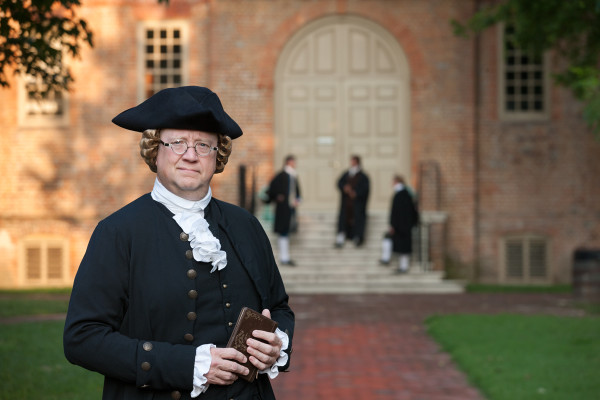 Exactly 209 years ago today, on June 8, 1806, scandal rocked Virginia. Beloved signer of the Declaration of Independence and America’s first law professor, George Wythe, was dead. The cause? Poison. Let’s take a look at the facts surrounding this case.
Exactly 209 years ago today, on June 8, 1806, scandal rocked Virginia. Beloved signer of the Declaration of Independence and America’s first law professor, George Wythe, was dead. The cause? Poison. Let’s take a look at the facts surrounding this case.
If you’re like me, you love a good murder mystery. And if you’re really like me, you love a good murder mystery of historic, epic proportions. Did Lizzie Borden kill her father and stepmother? That case continues to fascinate me to this day.
Nearly 100 years before the mysterious deaths of Andrew and Abby Borden in Massachusetts, a similar case occurred just a few miles down the road in Richmond, where Wythe had moved about 15 years prior. On a late May morning, George Wythe’s grandnephew, George Wythe Sweeney, informed Lydia Broadnax that he would not be dining with his great uncle for breakfast. According to Lydia, he poured himself a cup of coffee from the pot on the stove and then threw a piece of paper into the fire. Thinking nothing of it, she served Wythe and 16-year-old Michael Brown coffee from the same pot and poured some for herself.
All three became violently ill.
Lydia would survive the incident. It would take a week for Michael Brown to succumb to his illness and a week after that, George Wythe died. On his deathbed, Wythe exclaimed “I am murdered!”
 But what happened? Was Wythe’s exclamation that of someone whose mind was suffering or did he know much more? While Wythe never directly named his supposed killer, it didn’t take much for the finger to be pointed at his grandnephew.
But what happened? Was Wythe’s exclamation that of someone whose mind was suffering or did he know much more? While Wythe never directly named his supposed killer, it didn’t take much for the finger to be pointed at his grandnephew.
Sweeney had been no stranger to the darker side of Richmond. He reportedly got involved in gambling and racked up a lot of debt. According to Julian Boyd, who published an essay titled “The Murder of George Wythe” in a 1955 edition of the William & Mary Quarterly, Sweeney forged Wythe’s name on six different checks “probably to cover gambling or other debts” only a month before the poisoning.
“Sometime late in May, 1806, it doubtless became apparent to Sweeney that his criminal act of forgery would soon be revealed, and it is possible that the avenue of escape which suggested itself to him was that of covering up a smaller crime by a greater. He procured what must have been a considerable quantity of yellow arsenic, much of which was later found in his room. Such a purchase presented no more difficulty in the agricultural Virginia of 1806 than it would present today.” - Julian Boyd
Sweeney was eventually charged with the murder of both Wythe and Brown and would go on trial in September of 1806. The surviving victim and the only witness in the case, Lydia Broadnax, had told several people about what she saw that day, but Virginia law would keep her from taking the stand at Sweeney’s trial. The law stated that a person of color was not allowed to testify against a white man, even thought Lydia was free and not a slave.
“Lydia Broadnax, the cook, who was the chief witness, was not a slave but a freed woman. Yet, because of the texture of her skin, Virginia justice was unable to punish the murderer for a crime which the President of the United States, the attending doctors, the examining courts, and the victim himself believed to have been committed. Surely there is irony in the fact that the death of the great and benevolent Chancellor, who believed that kindness and freedom for Negroes were for the best interests of his beloved Commonwealth, went unavenged by his native state in part because of this legal repression of Negro evidence.” - Julian Boyd
Because of this, the prosecution couldn’t bring up the coffee evidence and instead had to suggest Sweeney poisoned strawberries. Despite the evidence against him—an eyewitness, the poison found in his room, the forged checks—Sweeney was acquitted of murder.
It’s one of the biggest injustices in the world to me. None of Lydia’s words were ever used in a court of law, and that was what ultimately allowed Sweeney to get away with murder. One of America’s founding fathers and the very first professor of law wouldn’t have the justice he rightly deserved.
It should be noted that Sweeney was convicted of forging the checks and was sentenced to six months in prison and one hour in the pillory. But in another gut-wrenching miscarriage of justice, that sentence was never carried out.
In 2012, we recorded a podcast about Wythe’s death aptly titled “I am murdered.” Click here to take a listen. Wednesday, I’ll bring you a review of a book about the case also titled “I Am Murdered” by Bruce Chadwick. Subscribe to the blog so you don’t miss it!
What do you think? Was George Wythe Sweeney guilty?





I read the book and it seems that he was murdered by his nephew. Unfortunately because of the laws of that time we will never know. Besides, no one knows where Mr. Wythe is actually buried in the cemetery.
dina says
What a fascinating piece of history. I remember touring the Wythe House when we visited a few years ago. Our tour guide told us it was haunted, but I didn’t know the story behind it!